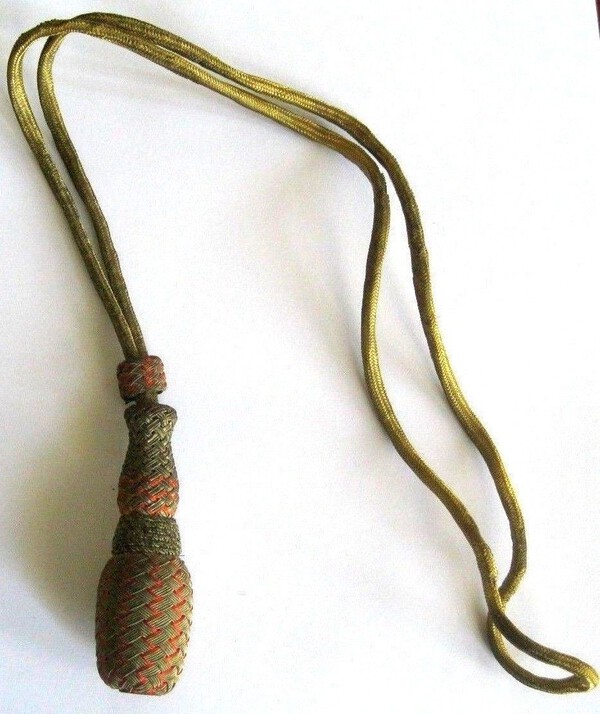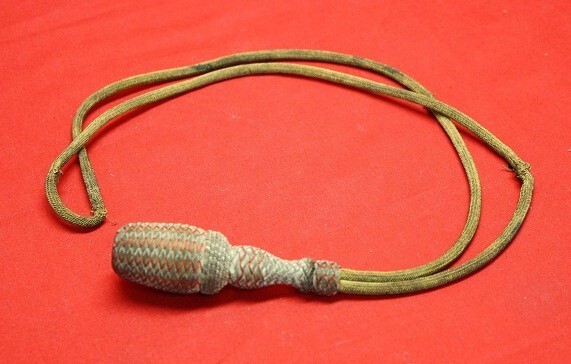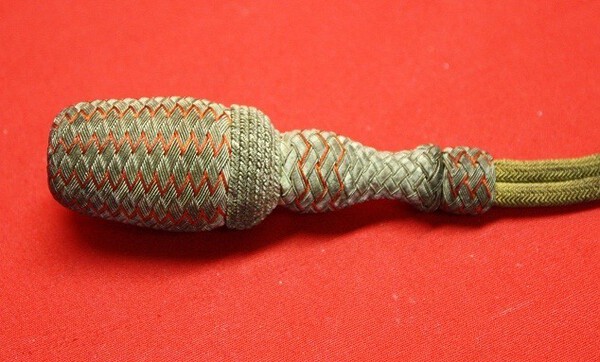-
Posts
147 -
Joined
-
Last visited
-
Days Won
1
Everything posted by Johnny Barracuda
-
In concur with Brian. It seems genuine (reinforced corners, toning, ink fading, red ink tone) but I have seen a few good fakes, including in Japan. If it is genuine, the price is good. I have a similar one but with the sunrays and my wife was rather adamant about not having it framed and hung to the wall!
-

Minatogawa Emblem On A Sake Bowl.
Johnny Barracuda replied to Dave R's topic in Military Swords of Japan
Hello Dave, I have seen a similar cup last summer in Japan. Apparently, those could be purchased by officers from the same sources as swords (officers clubs, etc).- 1 reply
-
- 1
-

-

Imperial Japanese Navy Sword Knot
Johnny Barracuda replied to Dansan's topic in Military Swords of Japan
Indeed there is. I stand corrected, because petty officers were entitled to black knots. I was too focussed on officers! However, regarding the variations for officers knots, that G & F. quote directly from the military regulations, Dawson indicates that some provisions of the Military regulations regarding said knots pre-1914 were probably never enforced. A good example is the red and gold knot for Cavalry field officers illustrated in the Japanese Military Uniforms 1841-1929 book, which probably never existed in reality. Furthermore, the drawings from the regulations are rather imprecise. -

Wwii Nco Sword Has Me Stumped
Johnny Barracuda replied to Ju Haralson's topic in Military Swords of Japan
I concur. Fake. Fantasy stamps and tip of the bohi is juste wrong. Sorry for you. -

Imperial Japanese Navy Sword Knot
Johnny Barracuda replied to Dansan's topic in Military Swords of Japan
Dan, The picture is small, but the sword knot on the first Naval kyu gunto you linked to on Ohmura's site looks suspiciously like an Army field officer rank (i.e. major to colonel, see attached pics) kyu gunto sword knot, in that it seems completely golden and the acorn is a bit more tapered than on a Naval knot. So it would not be the right knot for this kind of sword. Regarding Admiral Togo's sword (and not sabre, I have seen it in Japan, it is magnificent!), it is a flag rank sword predating 1914 (it accompanied him at the Battle of Tsushima), as evidenced by the specific floral motif on the guard (despite its abolition in the Navy, this motif was maintained in the colonial administration on sabres for senior civil servants). It bears the regulation sword knot. As regards the Naval kyu gunto, the main change in 1914 was the suppression of the admiral flag rank sword. I would have to check my documents to ascertain whether there was some actual change in the shape of the sword knot, but I would think not. As exposed before, the metallic Naval sword knots tend to turn silverish/greenish with age, but were originally golden, never silvery (see attached pic, it looks green, but when you have it in hand you notice easily its original colour). Cotton sword knots, when clean, stay tan. In Thomas' picture, look closer and you will see the minor differences in shape and material. -

Imperial Japanese Navy Sword Knot
Johnny Barracuda replied to Dansan's topic in Military Swords of Japan
The Naval kyu-gunto / dress sword knot is peculiar because, contrary to its Army equivalent, it is unique for all ranks, as is the post-1937 Naval sword tassel for the kai gunto. It is acorn-shaped, with a stem (the general shape is similar to the Army field officer rank kyu gunto knot) and, as Thomas pointed out, the material employed is either golden metallic or tan cotton threading. When made with golden metallic threading, it has a tendancy to turn slightly greenish with age and the sling part is much more rigid than on an Army kyu gunto knot. It features additional vertical parallel red zig-zag cotton over-threading, ending in a red round cap at the bottom of the acorn, figuring a stylised rising sun. Last but not least, there are slight variations, depending on the maker of the knots (see attached pictures of metallic ones). -
I concur. Such an amount of rust on a showato mean that polishing it away would cost more that the whole value of the sword!
-

Kyu Gunto Release Catch Broken Spring
Johnny Barracuda replied to Johnny Barracuda's topic in Military Swords of Japan
Yes, and thank you so much Thomas.I now have to try it on the sword. Here is the story: I provided Thomas with my professional address, without the name of the company because I am also personally registered on this professional address. Apparently, some French postmen, when provided with a professional address with the name of a person instead of the name of the company, do not wonder whether the person in question works on the premises of the company and do not bother to try to deliver the letter. My firm recently moved to a new headquarters and we never had this kind of issue in the previous district. We moved to the paradise of stupid and lazy postmen! -
It depends. If you have relevant kogai and/or kozuka, or better a matching set of both, contemporaneous to your blade, one or two pockets could be marvelous. On the other hand, if you have no such kogai and/or kozuka or only later examples, A remains a sound solution, but I am not exalted by tsuba-plugging.
-
To be more constructive than on my first message, be very careful when contemplating the purchase of a gunto, especially a shin gunto, because the market is flooded with Chinese fakes. Sadly, the same is beginning with the kyu gunto. If you want the purchase a gunto, buy it from a well respected seller. If you want to collect gunto, buy books on the subject and study them. The Dawson book (Military swords of imperial Japan 1868-1945) is the most lavishly illustrated and the Fuller book (Military and civilian swords and dirks of Japan 1848-1945) is the most useful for advice on fakes. Both books are expensive, the Dawson is very heavy therefore costly on postage and the Fuller & Gregory is OOP so scarcity makes the price. Roughly speaking, buying both books amounts to a $250 to $300 investment in total. So if it a one-time project, check the "For Sale" column of the NMB or buy online from a specialist on Japanese swords or militaria. Otherwise, buy the two above-mentioned books and study them.
-
Painfully fake.
-
If it is full size and not parade, I know I would be interested in the sword! A full-size general grade kyu gunto is rare indeed. As for the sword knot, it was a rather common design during the second half of the 19th century: it could be Japanese (diplomatic as Hamish stated), German, or even from the American Civil War! However, Japanese diplomatic swords are not that popular and most ofter sold with their own knot. So I would value the said knot around $300 to $400.
-

Importing/Exporting and Customs queries and advice
Johnny Barracuda replied to Brian's topic in Swords and Edged Weapons
When I told the seller that due to his sending through EMS, meaning automatic customs check, I received an EUR 80 extension, he royally refunded me USD 15 (ie EUR 12). Then EMS told me that the high import duties were the seller's fault. The seller had forgotten to write on the parcel that the sword tassel was an antique. Therefore I could not qualify for reduced VAT (rate of 5.5% instrad of 20%). Any proper antique seller (this seller has an ebay store selling Japanese antiques) knows that antiques benefit from reduced import duties and/or VAT in most countries and should be manifested as such on the parcels. Therefore, I posted neutral feedback on eBay with a comment on the seller's costly ignorance of international VAT practices on antique items. The seller immediately ordered me to send him back his royal refund and told me that the extra cost was basically my fault. When I of course declined and reminded him of the antique VAT issue, he became very agressive and insulting. As a conclusion, I would recommand against dealing with this seller. He goes by the eBay ID edokura -
Ethnically speaking, they share more roots with modern day Koreans than with Manchou or Chinese Han.
-
I concur, what is the point? Furthermore, whatever the seller calls them, those a replica army shin gunto. If there are two suspension mounts on an army shin gunto, it is not a murata to, it is a type 94 shin gunto from 1934 (first type, later simplified with a single suspension mount in 1938, the well known type 98). At the time of General Murata (1890s), the relevant mounting was a kyu gunto mounting. The shin gunto was authorised 40 years later. The swords could have been remounted as shin gunto later, but what makes a murata to is the very specific, and non-traditional, way the blade was made. Therefore, selling replica type 94 shin gunto as replica murata to is irrelevant and wrong. And yes, murato to are illegal in Japan.
-

Unusual "mon" Or Symbol On A Kyu-Gunto
Johnny Barracuda replied to Mark's topic in Military Swords of Japan
This pommel ornament looks indeed like an unusual variation of the diverse police insignia that can be found on police swords. However, there is normally only one circle in the centre. -

Importing/Exporting and Customs queries and advice
Johnny Barracuda replied to Brian's topic in Swords and Edged Weapons
Lucky you. I got a 80 euro "price extension" thanks to EMS. -

Importing/Exporting and Customs queries and advice
Johnny Barracuda replied to Brian's topic in Swords and Edged Weapons
Sorry to unearth this thread. I just got screwed on an import of kyu gunto tassel from Japan. First, the seller sent it by EMS without telling me beforehand (EMS always puts stuff through customs), second he forgot to write that it was a more than 100 years old antique (therefore VAT 20% instead of 5.5%), third, he declared the full price, which does not reflect the actual value because it is basically 2.5 times the price one would pay in Japan for such militaria (full taxation). The tassel became a lot more expensive. I do not know what it is with Japanese people and EMS, doesn't the Japanese postal service propose a signed for international parcel service? -
Anyhow, this is steel, therefore a 30 kg package should not be that big.
-
Indeed. They have bits of various size. The most difficult task, when you go there for the first time, is to locate the Museum! Funny story: I wanted to pruchase sword bags at the Museum (they have nice and affordable ones), and the lady asked me for which kind of sword I required bags. When I replied that it was for gunto, she was positively horrified, and when I specified kyu gunto, she looked at me as if I was demented. She flatly refused to sell me any sword bag. Strangely, at the Yasukuni shrine, people were far more open-minded about gunto... I really do not know why
-

Kyu Gunto Release Catch Broken Spring
Johnny Barracuda replied to Johnny Barracuda's topic in Military Swords of Japan
Well, the job is done now and the sword is actually better than it was before, because the swordsmith did a general check-up and fixed a few minor issues. It was a bit costly but woth it. -

Kyu Gunto Release Catch Broken Spring
Johnny Barracuda replied to Johnny Barracuda's topic in Military Swords of Japan
Stupidity has a price. I my case, including the cost of the spare part and the swordsmith, around 225 euros.










